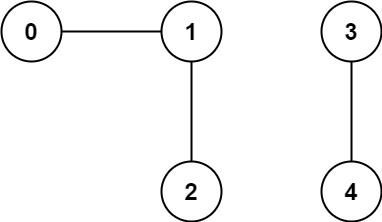You have a graph of n nodes. You are given an integer n and an array edges where edges[i] = [ai, bi] indicates that there is an edge between ai and bi in the graph.
Return the number of connected components in the graph.
Example 1:
Input: n = 5, edges = [[0,1],[1,2],[3,4]] Output: 2
Example 2:
Input: n = 5, edges = [[0,1],[1,2],[2,3],[3,4]] Output: 1
Constraints:
1 <= n <= 20001 <= edges.length <= 5000edges[i].length == 20 <= ai <= bi < nai != bi- There are no repeated edges.
Companies:
Amazon, Facebook, Microsoft, LinkedIn, Apple
Related Topics:
Depth-first Search, Breadth-first Search, Union Find, Graph
Similar Questions:
// OJ: https://leetcode.com/problems/number-of-connected-components-in-an-undirected-graph/
// Author: github.com/lzl124631x
// Time: O(E + N)
// Space: O(N)
class UnionFind {
vector<int> id;
int cnt;
public:
UnionFind(int n) : cnt(n), id(n) {
iota(begin(id), end(id), 0);
}
int find(int a) {
return id[a] == a ? a : (id[a] = find(id[a]));
}
void connect(int a, int b) {
int p = find(a), q = find(b);
if (p == q) return;
id[p] = q;
--cnt;
}
int getCount() {
return cnt;
}
};
class Solution {
public:
int countComponents(int n, vector<vector<int>>& E) {
UnionFind uf(n);
for (auto &e : E) {
uf.connect(e[0], e[1]);
}
return uf.getCount();
}
};
